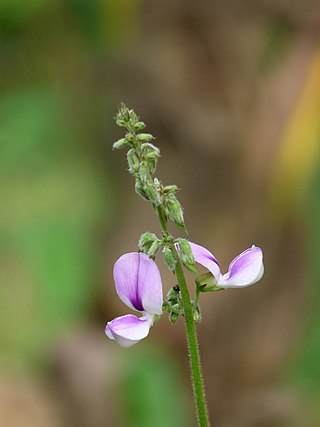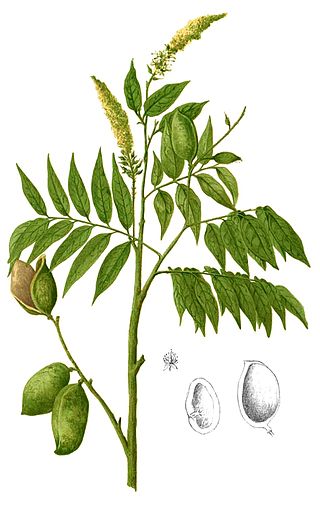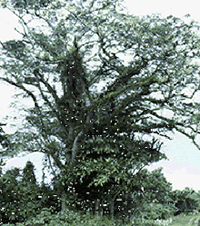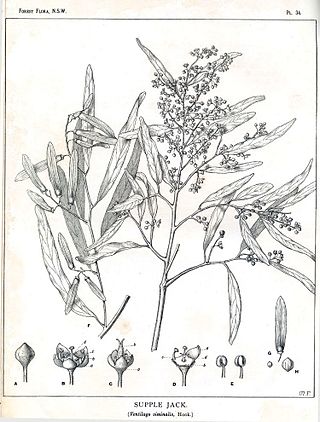
Dalbergia is a large genus of small to medium-size trees, shrubs and lianas in the pea family, Fabaceae, subfamily Faboideae. It was recently assigned to the informal monophyletic Dalbergia clade : the Dalbergieae. The genus has a wide distribution, native to the tropical regions of Central and South America, Africa, Madagascar and southern Asia.

Vigna is a genus of plants in the legume family, Fabaceae, with a pantropical distribution. It includes some well-known cultivated species, including many types of beans. Some are former members of the genus Phaseolus. According to Hortus Third, Vigna differs from Phaseolus in biochemistry and pollen structure, and in details of the style and stipules.

Glycine is a genus in the bean family Fabaceae. The best known species is the cultivated soybean. While the majority of the species are found only in Australia, the soybean's native range is in East Asia. A few species extend from Australia to East Asia . Glycine species are used as food plants by the larvae of some Lepidoptera species: the engrailed, nutmeg and turnip moths have all been recorded on soybean.

Pueraria is a genus of 15–20 species of legumes native to south, east, and southeast Asia and to New Guinea and northern Australia. The best known member is kudzu, also called Japanese arrowroot. The genus is named after 19th century Swiss botanist Marc Nicolas Puerari.

The plant tribe Phaseoleae is one of the subdivisions of the legume subfamily Faboideae, in the unranked NPAAA clade. This group includes many of the beans cultivated for human and animal food, most importantly from the genera Glycine, Phaseolus, and Vigna.

Centranthera is a genus of plants in the family Orobanchaceae. The genus is distributed in Asia. There are about 10 species in this genus, and the majority have funnel-shaped flowers. In Nepal, Centranthera cochinchinensis is reportedly used an alternate fodder.

Parkia is a genus of flowering plants in the family Fabaceae. It belongs to the mimosoid clade of the subfamily Caesalpinioideae. Several species are known as African locust bean.

Crudia is a genus of plants in the family Fabaceae.

Ormosia is a genus of legumes. 131 living species, mostly trees or large shrubs, are native to the tropical Americas, from southwestern Mexico to Bolivia and southern Brazil, to southern, southeastern, and eastern Asia, and to New Guinea and Queensland. Most are tropical, while some extend into temperate temperate regions of China. A few species are threatened by habitat destruction, while the Hainan ormosia is probably extinct already.

Serianthes is a genus of flowering plants in the family Fabaceae. It includes 17 species of trees and shrubs which range from Thailand and Malesia to Papuasia and the South Pacific. New Caledonia has the greatest diversity of species, with six endemic species. Typical habitats include tropical rain forest, scrub forest, coastal scrub, and rarely open wooded grassland.

Kibatalia is a genus of trees and shrubs in the family Apocynaceae, tribe Malouetieae, first described as a genus in 1826. It was initially called Hasseltia, but this turned out to be an illegitimate homonym. So Kibatalia was chosen as a replacement name. Kibatalia is native to China and Southeast Asia.
- Kibatalia arborea(Blume) G.Don – Thailand, Philippines, W Malaysia, Borneo, Sumatra, Java, Sulawesi
- Kibatalia blancoi(Rolfe ex Stapf) Merr. – Philippines
- Kibatalia borneensis(Stapf) Merr. – Sarawak
- Kibatalia elmeriWoodson – Luzon
- Kibatalia gitingensis(Elmer) Woodson – Philippines
- Kibatalia laurifolia(Ridl.) Woodson – Vietnam, Cambodia, Thailand, W Malaysia
- Kibatalia longifoliaMerr. – Mindanao
- Kibatalia macgregori(Elmer) Woodson – Sibuyan
- Kibatalia macrophylla(Pierre ex Hua) Woodson – Yunnan, Indochina
- Kibatalia maingayi(Hook.f.) Woodson – Thailand, W Malaysia, Borneo, Sumatra, Mindanao
- Kibatalia merrillianaWoodson – Leyte, Samar
- Kibatalia puberulaMerr. – Samar in Philippines
- Kibatalia stenopetalaMerr. – Luzon, Dinagat, Mindanao
- Kibatalia villosaRudjiman – W Malaysia, Borneo
- Kibatalia wigmani(Koord.) Merr. – Sulawesi
- Kibatalia africana(Benth.) Merr. = Funtumia africana(Benth.) Stapf
- Kibatalia elastica(Preuss) Merr. = Funtumia elastica(Preuss) Stapf
- Kibatalia latifolia(Stapf) Merr. = Funtumia africana(Benth.) Stapf
- Kibatalia scheffieri(K.Schum.) Merr. = Funtumia africana(Benth.) Stapf
- Kibatalia zenkeri(K.Schum.) Merr. = Funtumia africana(Benth.) Stapf
Mapania is a genus of plants in the family Cyperaceae. It contains 100 species, distributed in tropical regions of Africa, India, southern China, Southeast Asia, New Guinea, Australia, Central America, northern South America, and various oceanic islands.

Ventilago is a genus of plants in the family Rhamnaceae. It includes about 40 species found in the tropics of South and SE Asia, Australasia, with one species each in Africa and Madagascar.

Dendrolobium is a genus of flowering plants in the legume family, Fabaceae. It belongs to the subfamily Faboideae. It includes 21 species of mostly trees and shrubs and rarely herbs. Species range from eastern Africa to Madagascar, India, Indochina, southern China, Malesia, Papuasia, northern and western Australia, and the southwestern Pacific. Typical habitats include seasonally-dry tropical forest and woodland, bamboo thickets, and grassland.

The tribe Desmodieae is one of the subdivisions of the plant family Fabaceae. It is composed of two subtribes, Desmodiinae and Lespedezinae. Recent phylogenetics has this tribe nested within tribe Phaseoleae.

Dendrophthoe is a genus of hemiparasitic shrubs found in Asia and Australia known as mistletoes. The genus was described by German naturalist Carl Friedrich Philipp von Martius in 1830. Species in this genus have a variety of reported uses in the medical traditions of the region, most notably in Nepal.

Phanera is a genus of flowering plants in the legume subfamily Cercidoideae and the tribe Bauhinieae. This genus differs from Bauhinia in being vines or lianas, generally with tendrils and a lobed rather than spathaceous calyx, and from Schnella in having only three fertile stamens rather than ten, and being native to the Indomalayan realm and the Australasian realm rather than the Americas. The subsection Corymbosae was recently segregated into a new genus, Cheniella. It has been suggested that the genus Lasiobema should be reduced to a section within Phanera.
Tateishia is a genus of flowering plants belonging to the family Fabaceae.
Oxytes is a genus of flowering plants belonging to the family Fabaceae.















